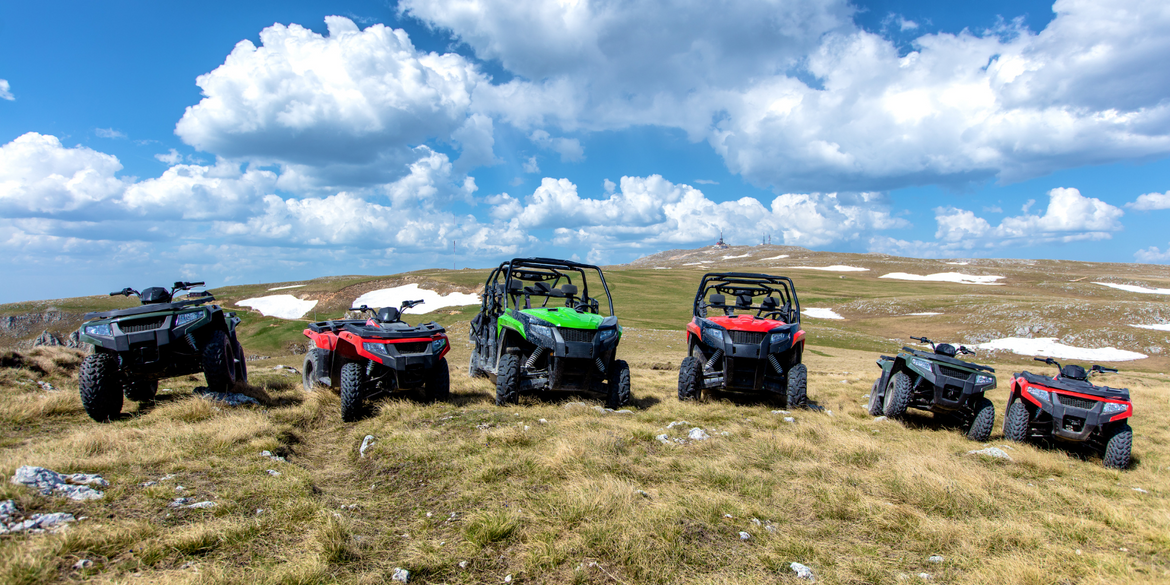
What Is a UTV vs. an ATV?
- on April 03, 2024
- Categories: Articles
Many ask, "What is a UTV vs. an ATV?" when looking at off-road vehicle options, and that's an important question. In short, a UTV is a utility task vehicle, and an ATV is an all-terrain vehicle. However, the differences go beyond the name, and understanding them will inform your purchase decision.
What Is a UTV vs. an ATV, and What Are Their Main Purposes?
You want to consider the purpose behind your off-road vehicle purchase before settling on an ATV or a UTV. Some consider them synonymous, but their uses can be vastly different. ATVs are generally for recreation. They carry one or possibly two riders and are perfect for trail riding. Wide tires and agile handling make ATVs perfect for riders who enjoy a good adrenaline rush and can get some good speed out in nature.
UTVs are usually work vehicles. You'll find them on farms and construction sites. While they can go on trails, they're much larger than an ATV and won't fit on many of the trails an ATV fits on. UTVs can carry passengers, making them a good choice for adventures and excursions that can accommodate larger vehicles.
What Is the Difference Between a UTV and an ATV?
What is a UTV vs. an ATV in terms of characteristics? When considering this, you want to look at several things.
Seating
ATVs are solo machines. You can add certain accessories to accommodate one passenger on some vehicles, but not all have that capacity. UTVs hold several riders. For example, the TrailMaster Challenger 4-200x holds four adults.
Cabin
You generally won't see an ATV with an enclosed cabin because it is for the true, off-road experience. Some ATV owners purchase an accessory that can enclose the cabin, but most don't consider it. UTVs have an enclosed cabin, a roll cage, seatbelts, and a windscreen. This increases safety and comfort for those not looking for as big a thrill as ATV riders.
Steering
Regarding steering, the difference between what a UTV vs. an ATV is how the vehicle handles. When driving an ATV, you use a handlebar and twist throttle. This allows greater agility and control when you're off-roading on rough terrain. UTVs handle more like a car, with a steering wheel and foot pedals that control both the brakes and acceleration.
Power
ATVs can reach speeds up to 85 miles per hour and can do so fairly quickly. They don't have a heavy frame and do not carry heavy loads, so they can accelerate fast. With this type of power, ATVs are the perfect vehicle for adventure and racing.
UTVs have incredible torque and can pull a heavy load without slowing down or feeling sluggish. The power required for UTVs is steady and strong, ensuring you can get your work done, climb a mountain, or get to where you need to be, making power an important consideration when comparing what is a UTV vs. an ATV.
How Do a UTV and an ATV Differ in Price?
If you're saving up for your new vehicle, understand that UTVs will be more expensive. This is understandable, given that they are larger and have a roll cage, seat belts, and other features that ATVs don't have. This is important because your budget is one of the most important factors when purchasing a UTV vs. an ATV.
If you're planning to modify your vehicle, you must also consider the costs. It may be more cost-effective to purchase a stock UTV than to get a stock ATV to which you then add a cage or additional seating modifications. You can also modify your UTV, so remember to add those changes to your proposed budget.
Safety is essential when riding an ATV or a UTV. Your budget should include line items for helmets, gloves, heavy-duty boots, and protective clothes. Depending on how you use and transport your new off-road vehicle, you might need a line item for a trailer, trailer straps, and loading ramps. These expenses apply to both an ATV and a UTV.
Which Is Safer, an ATV or a UTV?
What is a UTV vs. an ATV when it comes to safety? A UTV is similar to a car regarding safety features such as seatbelts and enclosures. They can get up to 80 miles per hour, but with their main purpose being work-related use, most drivers will not go that fast. When trail riding in a UTV, drivers tend to go slower to stay comfortable and keep their vehicle in better shape, increasing safety.
ATVs are the less safe option. Because they are made for speed and excitement, most drivers use them for just that. They do not have the same safety features as a UTV or car, so drivers need to practice caution when riding. ATVs can handle rough terrain and sharp curves, which increases the danger factor. Rest assured, when properly trained, drivers can remain safe on an ATV, even without the added features of a UTV.
What Are Other Reasons To Love ATVs and UTVs?
ATVs and UTVs are versatile vehicles with a wide range of possibilities. In this regard, what a UTV vs. an ATV is can often be similar. For example, they can have a plow attached to the front for snow. UTVs are better equipped for heavy snow, but ATVs also have the capacity to plow a light snowfall. Both are easy to get dirty but also easy to clean. Put them on a trailer and take them through a self-serve car wash, or hose them off when you return home.
ATVs and UTVs are convenient. If you need to run to the back of a large property to check on livestock, an ATV gets you there and back in no time. If you want to drive up the canyon on a summer evening, a UTV makes it more enjoyable.
What Is a UTV vs. an ATV, and Which Should I Purchase?
Several ATV and UTV models are available, so it could be overwhelming trying to figure out which to purchase. Check out our selection, read about the different features and capabilities, review your budget, and decide which would work best for your purposes. What is a UTV vs. an ATV when it comes to purchasing? That's up to you! Start looking today.









